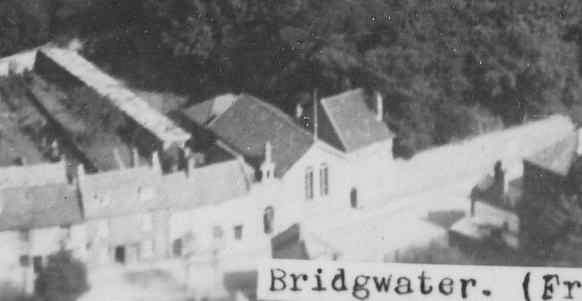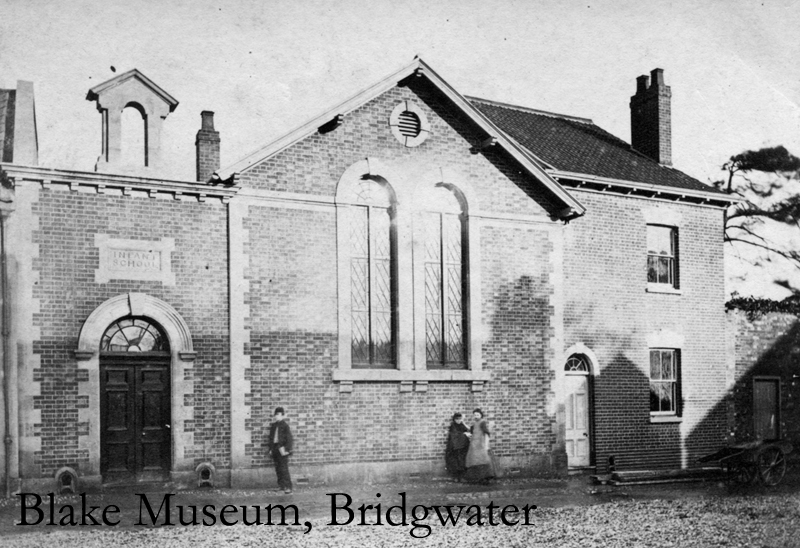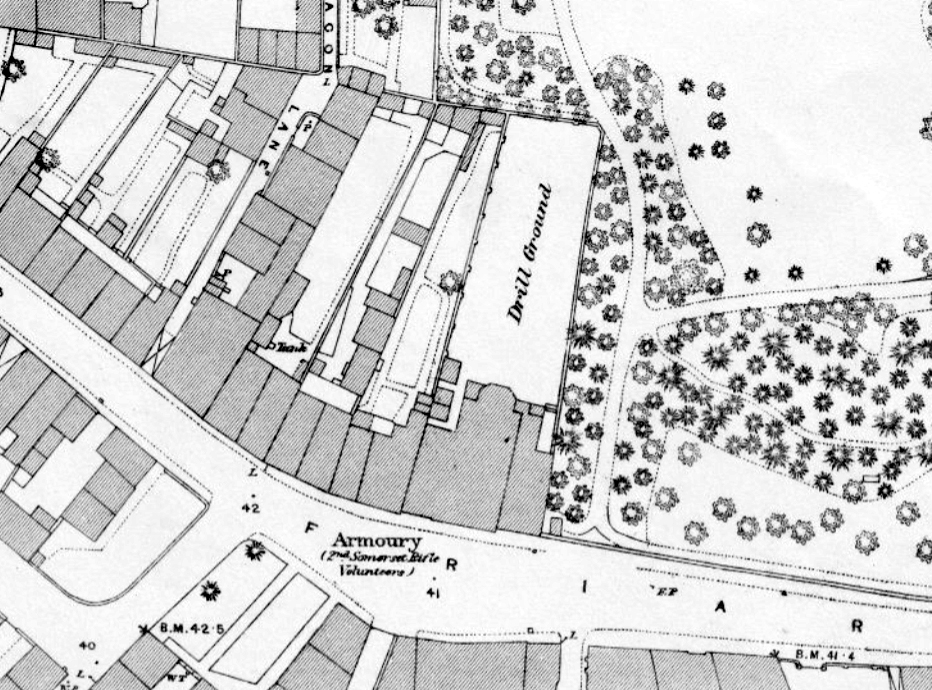
The site now occupied by 68-70 Friarn Street is mentioned in 1625, when what probably became 68 was leased by Richard Willoughbye of London to William Wallis of Bridgwater. The property was described as a ‘decayed tenement and garden’, a quarter of a burgage in width, and had previously been part of the property of one of the chantry chapels inside St Mary’s Church. In 1652 Nicholas Douthwaite of London leased the same plot to William Androse of Bridgwater, along with a burgage plot containing a tenement and garden, which is presumably what became number 70. In 1661 Androse leased both plots to Edward Sealy of Bridgwater. Three years later, presumably after Androse had died, Roger Bourne re-leased the plots to Sealy, now described as a barn and garden. In 1692 Edmond Borne granted a 10,000 year lease to William Sealy of Exeter (Somerset Heritage Centre DD/S/WT/7). The 1835 Bridgwater Borough Property report mentions how the plot had been held by Edward Sealy of Bridgwater in 1661, and was known as ‘Sealy’s Land’, and later ‘Miss Sealy’s Land’.
The full-burgage size plot may be the tenement described as a ‘Messuage and tenement in Friarn Street near Friarn Gate’ in a series of documents dating to 1557-1661, which also mention Androse and Sealy (SHC D/B/bw/CL/69). Friarn Gate was the old entrance to the Franciscan Friary, now obliterated by the Broadway, which was directly opposite the plot.
In 1775 Levi Ames of Charlton and his wife Sarah, nee Sealy, along with her sister Elizabeth Sealy of Bridgwater (evidently joint heirs of some of the Sealy properties in the town) granted the double plot in trust to the ‘Presbyterian Meeting House’ (later Christchurch Unitarian Church) as a place for the congregation’s minister to live.

In 1835 the property was occupied by the Rev William James, a Unitarian minister. It seems that at this time the property was known as ‘Parsonage House’. (B. Lawrence, Coleridge and Wordsworth in Somerset: 1970, p 39). This name may recall its ownership by one of the chantries of St Mary’s, although given the dubious name given to the adjoining ‘Priory’, which was never the site of such an establishment, we might not read too much into it, beyond the fact a religious leader lived there. We should imagine the actual medieval parsonage house of St Mary’s Church, if there ever was one, to have been nearer the church itself.
While the Unitarians held the land, the rear of the property was used as a burial ground. This seems to have been arranged in 1833. Among the Unitarian papers held in the Somerset Heritage Centre is a document entitled ‘Christ Church Chapel as to making Garden into Burial Ground’:
/Copy/ Christ Church Chapel 10th February 1833. At a meeting of the Trustees and Subscribers held here this day pursuant to notice. Mr John Brown in the Chair. The Committee of management report that in pursuance of a resolution past the 4th November last, requesting them to turn their attention to a Burial Ground for the congregation, they have considered the subject, and in their opinion a very convenient Burial Ground may be made by taking a part of the garden belonging to the Chapel House and requirements having been made for the Reverend Mr James to occupy the House, they have reserved a portion of the garden, which may be applied to that purpose if the Trustees should so determine. Resolved That in the opinion of this meeting is it desirable that the Congregation should be in possession of a Burial Ground, and the Garden of the Chapel House offering an eligible one at a trifling expense, the Committee of management are requested to send a copy of this resolution to the resident Trustees and that this meeting be adjourned to Sunday next after the morning service, when the subject may be further considered and finally arranged. Signed Mr Browne Chairman
The surviving Unitarian burial register begins in 1833. This was the time a number of other congregations set up small independent burial grounds around the town (Independents, 1822; Wesleyans 1833; Baptists 1837, Mariners 1837). This burial ground was in use up to 1853, when new burials were then taken to the Wembdon Road Cemetery. The burial ground was closed for new burials by Act of Council in July 1854 and was converted into a garden for the school (Clare Sealey Notes).
The Unitarians also used the property as a school. We find mention of the opening of a Unitarian day school in Friarn Street in 1830, presumably in the ministers’ house. A school room was then built in 1834 and enlarged in 1842. Another school was built at Provident Place in 1850, although that was demolished in 1866 (Dunning, Victoria County History).
Around 1865 both Parsonage House and School were pulled down and both re-built – Reverend Timmins occupied the house. In November 1877 the Unitarians found they could no longer sustain the running of the school, so the building was then rented to the Bridgwater School Board for two years, until December 1879. A plaque on the building recorded its use as the ‘British School’, which presumably dated to these two years.

In 1880 the Unitarian’s received an application from the Officers of the town’s Volunteer Force to rent the Friarn Street property (Clare Sealey Notes). In John Whitby & Son’s Handy Directory of Bridgwater and Neighbourhood of 1883, the building is described as ‘Armoury of the I&K Companies, 2nd Volunteer Battalion Prince Albert’s Light Infantry’ (p.5). On the 1888 Ordinance Survey Town Plan the building is described as ‘Armoury (2nd Somerset Rifle Volunteers) with the rear of the property being marked as ‘drill ground’. Prior to 1880, the armoury seems to have been kept somewhere in the markethouse on the Cornhill. E.R.Kelly’s County Topographies: Somerset (1875) mentions:
The Corn Exchange was opened on 19 May 1875. The contractor for the building was Mr Thomas Searle, and the architect Mr Charles Knowles, late borough surveyor. The building presents an elegant appearance. The site is immediately behind that portion of the Market House formerly in use as a Corn Market; the Old Fish Market, and the staircase leasing to the Armoury of the 5th Somerset Rifle Volunteer Corps, being also converted for that purpose.

Bridgwater Mercury 24 August 1904
OLD BURIAL GROUND DISCOVERED AT BRIDGWATER
A discovery which has excited no little interest in Bridgwater was made in Friarn Street a few days ago, when it was found that a large yard at the rear of the Volunteer armoury, adjoining the residence of Sergeant-Instructor Moriarty, was nothing more nor less than an old disused burial ground, the existence of which seems to have been absolutely forgotten, and which has probably not been used for more than 60 years. The spacious though uneven yard has been utilised for drill purposes by the Volunteers for years past, and the surface of the yard gives no indication that underneath probably repose the remains of many who departed this life in the early part of the last century. The discovery was made under peculiar circumstances. Sergeant-Instructor Moriarty’s son was engaged with an iron bar in making a hole to put in a post for the erection of a swing when the bar suddenly dropped through the surface and disappeared from view. At the same instant a portion of the surface of the yard, three feet or more square, also gave way, and young Moriarty was only saved from falling through the opening which suddenly appeared at his feet by catching at some wire netting of a fowl house adjoining. Had he not saved himself in that way the boy would probably have been seriously injured, as he would have disappeared into what proved to be a brick-lined vault about 12 feet in depth and about 8 feet square. The boy made his parents acquainted with what had happened, and an inspection of the chamber speedily proved the purpose for which it had been built. The police were communicated with, and Sergeant Storey and others visited the spot. By means of a ladder he descended into the vault, in which there had evidently been three internments. The remains of one coffin, mixed with bones, are to be distinctly seen, while alongside other bones are to be discerned but without the least trace of coffins. Parallel are other remains, upon which was found a stone tablet recording the death of William champion on September 25, 1841, at the age of 17. The vault is very bare in construction, and seeing that the arch over it is only of one brick thickness and immediately below the surface of the yard it is surprising that it has not given way long before. The discovery led to inquiries being made, and it is has been found that the yard was formerly a burial ground used by the Unitarians in Bridgwater, and probably at one time the Armoury was utilised as their Chapel. The existing representatives of the champion family have been communicated with, and they will probably decide upon what action shall be taken with regard to the vault and its remains. It is very probable that the yard contains many vaults. In fact, the brickwork found underneath the surface in several places confirms this idea, while when the surface of the ground is struck in some places with an iron bar a hollow sound is produced. It is rather remarkable that with the frequent drilling of the volunteers in the yard the vault in question and others have not been broken in long before.
The Unitarian Burial Register (published in the Members’ section of the Friends of the Wembdon Road Cemetery website) tells us that William Champion was the son of Charles and Marianne Champion. The only other Champion prior to the creation of the Wembdon Road Cemetery in the register seems to be Mary Ann Champion, aged 54 of Dunwear, buried 19 July 1848. An annotation tells us she was the mother of Jane Price (wife of William Price Chemist), buried on 2 October 1847.
Bridgwater Mercury 31 August 1904
THE OLD BURIAL GROUND AT THE ARMOURY
Several of our readers have pointed out to us, in regard to the report in our last week’s issue, relative to the bringing to light of the old Unitarian burial ground at the rear of the Volunteer Armoury, that the existence of such a place of burial was well known to many of the older generation of town’s people. They also point out that the ground was closed about the year 1850, and that by an order of the Secretary of State many of the bodies were subsequently exhumed, and at dead of night removed and re-interred in the cemetery which had been newly opened on the Wembdon Road. We are also informed that the armoury was never utilised by the unitarians as a place of worship, but used by them as a school room.
The Friarn Street Armoury was still in use in 1913, when it is mentioned in connection to National Reserve (Taunton Courier, and Western Advertiser 20 August 1913, Shepton Mallet Journal 22 August 1913). It presumably ceased to function when the Unitarians were forced to sell the property in 1920. The Armoury then was moved to Blake Street, behind the old County Police Station.
It seems the Armoury became a garage in about 1924. By 1932 a garage door had been inserted below the two main windows (Britain from Above EPW039922). In 1944 the death of Mr Andrew Reed, aged 59 of East Bower, was mentioned as ‘proprietor of the motor garage at the Old Armoury, Friarn Street, where he had carried on his business for 20 years’ (Taunton Courier, and Western Advertiser 29 July 1944). By 1948 the business was referred to as ‘the Old Armoury Garage (Western Gazette 02 April 1948). In 1960 and 1967 Andrew Read, motor engineer, lived in the property, although E.G. Gunningham was listed as the proprietor – the Gunninghams having taken over from the Reads (Kelly’s Directory of Bridgwater, 1960, 1967-8).
In 1970 ‘a senior member of the Unitarian congregation recalled that the site of the petrol pumps was formerly a burial ground and that years ago she saw two old tombstones leaning against a wall of the house’ (Lawrence, Coleridge and Wordsworth, p.39).
Gunningham’s garage closed in the mid-1980s, as did the adjoining John Warren Car Sales, and the site became the centre for the Small Industry Group, run by a Mr Fred Weslake. An industrial steel building was erected on the car sales forecourt, which was occupied by former Clarks workers, after the Redgate factory closed. This was a cooperative, called Sew Unique (Pers Comm, Roy Snook).
In the 1980s and by 1987 the building was used as a photography studio and picture frame gallery, run by Arthur Woolaway. The business later moved to St Mary Street, first to the Inshops shopping centre in the Marycourt (now the Carnival Inn) where it operated until 2019 (Bridgwater Journal 14 February 1987; Bridgwater Mercury 6 December 2019).
The building remained derelict for a number of years in the early 1990s. In October 1992 68 bodies were exhumed from the burial ground and reburied in five coffins in two plots in the Quantock Road Cemetery (pers comm, BTC). Although the bones were preserved, there is no record as to what happened to the other artifacts, such as any recovered tombstones, coffin furniture or grave goods.
The building was demolished in about 1996 as part of the Priory Court development: apparently bomb disposal had to be called as live ammunition was found from the time the building had served the Volunteer forces.
MKP March 2021
With kind thanks to Bernice Lashbrook for sharing the notes of Clare Sealey, former Treasurer for the Unitarian Christchurch Congregation of Dampiet Street; Roy Snook for detailed notes on the later history of the site, along with Barney Bramble, John Boyland, Peter Kearle and Anne Caddick.
McCarthy and Stone were contacted to see if they had any record of the exhumations, but no records were apparently kept.
A note on the Unitarians in Friarn Street – transcribed by Dr Peter Cattermole
Lawrence, B Coleridge and Wordsworth in Somerset Newton Abbot: David & Charles 1970
p 39 John Howel (Unitarian Minister 1793, buried in Dampiet Street Unitarian School Room).
Mr Howel enjoyed the free use of a house known as the Parsonage House, and in spite of the demolition that has taken place in its vicinity it has proved possible, though difficult, to establish its identity, although the Meeting House records show only that it was situated in Friarn Street on ground known as Sealy’s, that in 1835 part of its garden became the Unitarian burial ground, that the house ceased to be the Parsonage House in about 1850. A study of the Corporation Schedule of Property (1836) reveals that it was a double-fronted house standing on the north side of Friarn Street, in line with the Green Dragon Inn. Calculations based on this evidence point to the fact that the Parsonage House was the property now called the Old Armoury Garage, which, in line with the Green Dragon and several pairs of old cottages, stands back a little distance from the carriage-way. The bright blue paint on the doors and window-frames of its double-fronted house makes it conspicuous. A senior member of the Unitarian congregation recalls that the site of the petrol pumps was formerly a burial ground and that years ago she saw two old tombstones leaning against a wall of the house.
Report of the Committee Appointed by the Council of the Borough of Bridgwater .. For Improving the Town 10th December 1836 Bridgwater: Whitby
Property Report Reference 26 reference to the Town Plan 362 Dwelling House and Garden North Side of Fryern Street In possession or occupation of Mr Thomas Hellier ref above – proposed to be sold.
